The Marquesan ground dove or Marquesas ground dove is a bird species in the family Columbidae. It is endemic to French Polynesia. Its natural habitats are subtropical or tropical dry forests and subtropical or tropical moist shrubland.

The Bamenda apalis is a species of bird in the family Cisticolidae. It is endemic to Cameroon.

The lowland masked apalis, also known as the masked apalis, is a species of bird in the family Cisticolidae. It is found in Angola, Cameroon, Democratic Republic of the Congo, Equatorial Guinea, Gabon, Tanzania, and Uganda. Its natural habitats are subtropical or tropical dry forest and subtropical or tropical moist lowland forest.
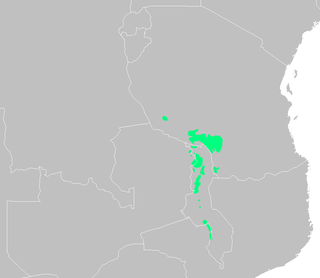
Chapin's apalis is a species of bird in the family Cisticolidae. It is found in Malawi, Tanzania, and Zambia. Its natural habitat is subtropical or tropical moist montane forest.

The white-winged apalis is a species of bird in the family Cisticolidae. It is found in Kenya, Malawi, Mozambique, and Tanzania. Its natural habitats are subtropical or tropical moist lowland forest and subtropical or tropical moist montane forest. It is threatened by habitat loss.
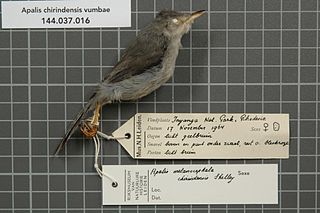
The Chirinda apalis is a species of bird in the family Cisticolidae. It is found in the Eastern Highlands of Zimbabwe and Mozambique. Its natural habitats are subtropical or tropical moist lowland forest and subtropical or tropical moist montane forest.
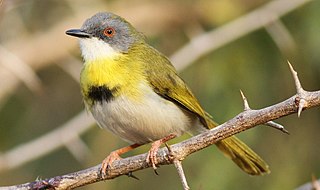
The yellow-breasted apalis is a species of bird in the family Cisticolidae.

The yellow-throated apalis is a passerine bird in the family Cisticolidae. It is endemic to Malawi. It was formerly considered a subspecies of the bar-throated apalis.

Gosling's apalis is a species of bird in the family Cisticolidae. It is found in Angola, Cameroon, Central African Republic, Republic of the Congo, Democratic Republic of the Congo, and Gabon. Its natural habitat is subtropical or tropical moist lowland forest.

The black-headed apalis is a species of bird in the family Cisticolidae. It is found in Kenya, Malawi, Mozambique, Somalia, Tanzania, and Zimbabwe. Its natural habitats are subtropical or tropical dry forest, subtropical or tropical moist lowland forest, and subtropical or tropical moist montane forest.
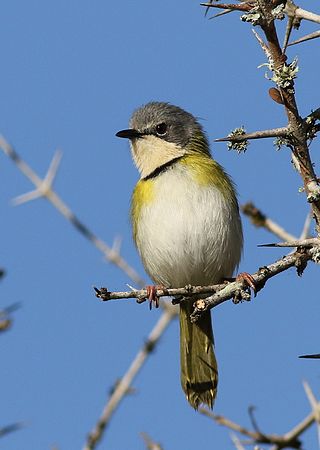
Rudd's apalis is a species of bird in the family Cisticolidae. It is found primarily in Mozambique but also in southern Malawi and adjacent areas of South Africa and Eswatini. Its natural habitats are subtropical or tropical dry forest and subtropical or tropical moist shrubland.
The Rwenzori apalis or collared apalis is a species of bird in the family Cisticolidae. It is found in Burundi, Democratic Republic of the Congo, Rwanda, and Uganda. Its natural habitat is subtropical or tropical moist montane forest.

Sharpe's apalis is a species of bird in the family Cisticolidae.
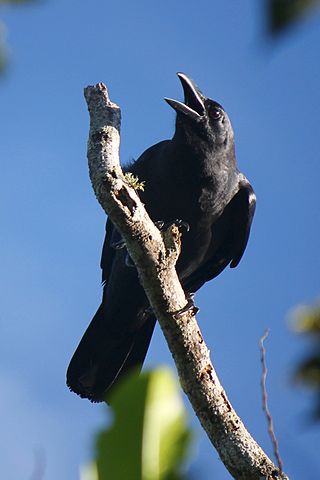
The slender-billed crow is a Passerine bird of the family Corvidae, in the genus Corvus. The violet crow has been found to be distinct genetically and separated as Corvus violaceus. The small crow has been split as Corvus samarensis and the Palawan crow has also been split as Corvus pusillus.
The Bougainville crow is a species of bird in the crow family, Corvidae.
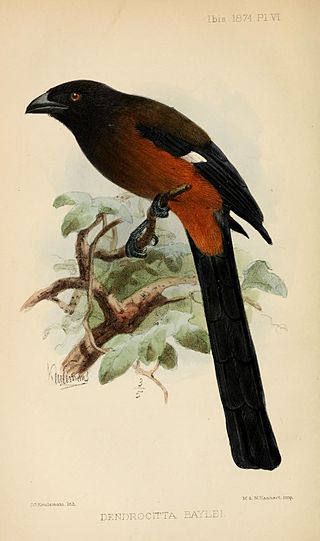
The Andaman treepie is a species of bird in the family Corvidae. First described by Robert Christopher Tytler in 1863, it is endemic to the Andaman Islands of India, where its natural habitat is subtropical or tropical moist lowland forests. It is threatened by habitat loss.

Bocage's bushshrike, also known as the grey-green bushshrike, is a species of bird in the family Malaconotidae. It is scatteredly present throughout central Africa. Its natural habitats are subtropical or tropical dry forest and subtropical or tropical moist lowland forest.
The Makira cicadabird is a species of bird in the family Campephagidae. It is endemic to the Solomon Islands. It used to be considered a subspecies of the common cicadabird.
The West African wattle-eye is a species of bird in the family Platysteiridae. It is found in Benin, Ivory Coast, Ghana, Guinea, Liberia, Sierra Leone, and Togo. Its natural habitats are subtropical or tropical moist lowland forests, subtropical or tropical swamps, and moist savanna.
The brown-tailed apalis is a species of bird in the family Cisticolidae.














